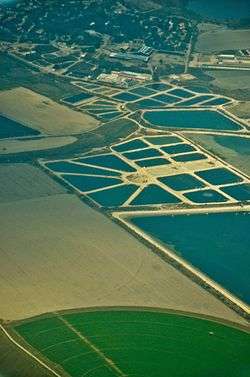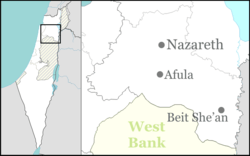Kfar Ruppin
Kfar Ruppin (Hebrew: כְּפַר רוּפִּין, lit. Ruppin Village) is a kibbutz in the Beit She'an Valley, about 5 km (3.1 mi) southeast of Beit She'an in northern Israel. A member of the Kibbutz Movement, it falls under the jurisdiction of Valley of Springs Regional Council. In 2018 it had a population of 493.[1]
Kfar Ruppin | |
|---|---|
 | |
 Kfar Ruppin | |
| Coordinates: 32°27′27″N 35°33′21.96″E | |
| Country | Israel |
| District | Northern |
| Council | Valley of Springs |
| Affiliation | Kibbutz Movement |
| Founded | 1938 |
| Founded by | Massad members |
| Population (2018)[1] | 493 |
| Website | www.kfar-ruppin.org.il |
History
The kibbutz was founded in 1938 by the "Massad" group as part of the tower and stockade enterprise. The first residents were members of the Noar Haoved youth movement immigrants from Germany, Bohemia and Austria,[2] and former members of a labour group from Herzliya.[3] It was named in honour of Arthur Ruppin, a Zionist leader who was at the time the head of the Settlement Department of the Jewish Agency and who helped the group with establishing the kibbutz[3] as part of his effort to develop Jewish settlement in the Land of Israel. The small group of settlers was facing very harsh living conditions, which led their parent movement to direct some 80 members of the "BeNativ" group to join them in 1942.[3] Most of these had arrived from Czechoslovakia travelling on illegal immigrant ships.[3]
Kfar Ruppin uses lands that belonged to the depopulated Palestinian village of Masil al-Jizl.[4]
From 2017, the Mechinat HaEmek (מכינת העמ"ק) pre-army preparatory academy moved to the kibbutz from the close-by moshav Tel Te'omim. The mechina was established in 2006 and admits both religious and secular men and women.[5] It is now in its twelfth session; learn and volunteer on the kibbutz and the surrounding area.
Economy
As of 2016, Kfar Ruppin's economy was fully privatised.[6]
In 2016, the largest part of the kibbutz revenue came from the privately managed[6] "Palkar" factory, established in 1978[3] for the production of plastic goods and already managed by an external company in 2000.[7]
Kfar Ruppin still has strong agricultural activities, with fish farming including ornamental fish breeding, dairy and chicken farms, date and red grapefruit plantations, and wheat and maize crops.[3]
Birdwatching
The area is known for birdwatching due to its location on one of the most important bird migration flyways between Europe and Africa.[8] A bird ringing station is also located there.[9] The kibbutz culture hall, built in 1965 on a hill near the original tower and stockade structures, is being converted into a birdwatching observatory and research center.[10]
Landmarks
Kfar Ruppin has a 50 acres (200,000 m2) public garden on the grounds of the kibbutz.[11]
Near the kibbutz is an archaeological site called Tel Tsaf, a 7,000-year-old prehistoric village which has produced the largest database of materials from the Neolithic to the Chalcolithic periods.[12]
Notable residents
See also
- Wildlife in Israel
- Tourism in Israel
References
- "Population in the Localities 2018" (XLS). Israel Central Bureau of Statistics. 25 August 2019. Retrieved 26 August 2019.
- p. 211, Gavron, Daniel, The Kibbutz: Awakening from Utopia, Rowman & Littlefield Pub. Inc., 2000, ISBN 978-0-8476-9526-3.
- The history of Kfar Rupin, on the homepage of the Jordan Valley Birding Center. Accessed 3 December 2019.
- Khalidi, W. (1992). All That Remains: The Palestinian Villages Occupied and Depopulated by Israel in 1948. Washington D.C.: Institute for Palestine Studies. p. 56. ISBN 0-88728-224-5.
- Beit Shean, on Nefesh B'Nefesh website, accessed 2019-12-3
- Eli Sperling (22 November 2016). "Changing the Kibbutz Movement in Israel". Atlanta Jewish Times. Retrieved 3 December 2019.
- p. 215, Gavron, Daniel, op. cit.
- Leiah Elbaum's Israeli Birdwatching site. Retrieved on 25-08-2009.
- International Birdwatching Center of the Jordan Valley. Retrieved on 25-08-2009.
- Disused kibbutz hall gets new life as birdwatching center, Haaretz
- Kfar Ruppin Gardens
- The Guide to archaeological fieldwork opportunities outside the UK Archaeology Abroad